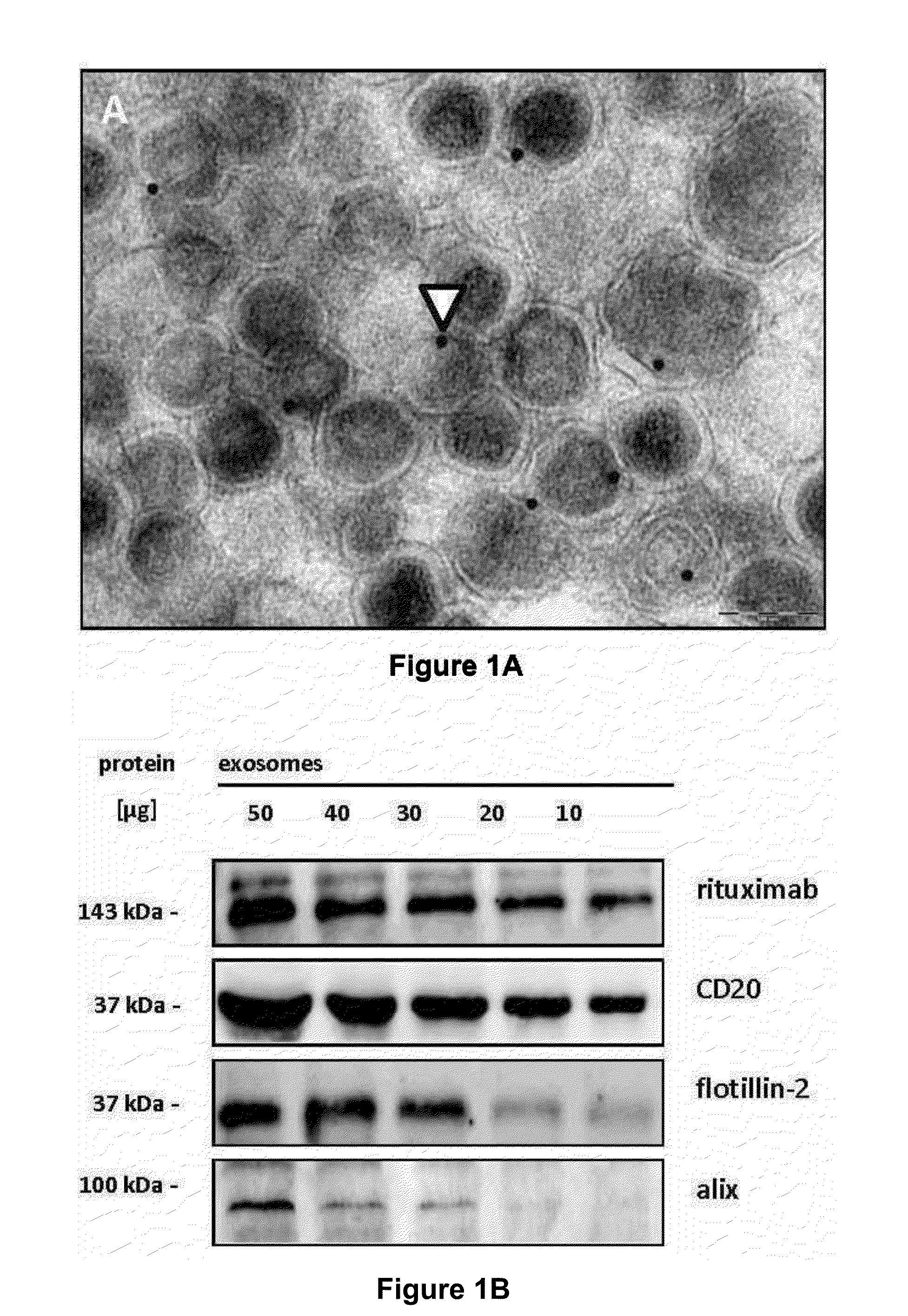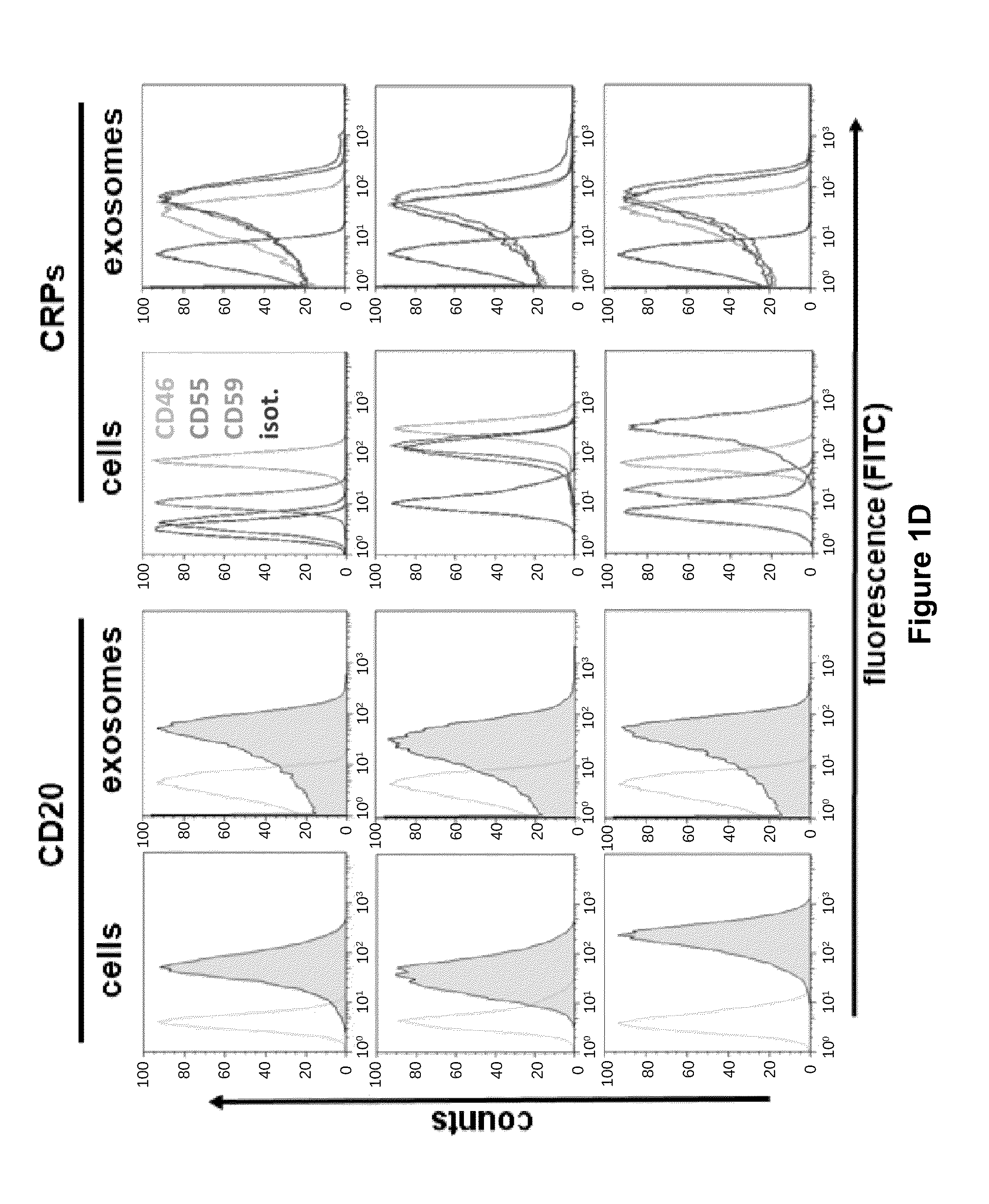Exosome inhibiting agents and uses thereof
a technology of exosomes and inhibitors, applied in the field of exosome inhibitors, can solve the problems of poor prognosis of primary resistant or relapsed aggressive lymphoma patients, susceptibility to immunochemotherapy, etc., and achieve the effect of strong exosome production and release and enhanced susceptibility of target cells
- Summary
- Abstract
- Description
- Claims
- Application Information
AI Technical Summary
Benefits of technology
Problems solved by technology
Method used
Image
Examples
example 1
Lymphoma-Derived Exosomes Bind Therapeutic Anti-CD20 Antibody
[0183]Applying ultracentrifugation techniques described for the isolation of exosomes from dendritic cells and erythropoietic progenitor cells (Thery, C., Zitvogel, L., & Amigorena, S, Nat. Rev. Immunol. 2, 569-579 (2002)), the inventors recovered monomorphic microvesicular structures of high purity with the typical size and morphology of exosomes in the supernatants from a series of aggressive B-cell lymphoma cell lines as well as from primary lymphoma cell preparations (FIG. 1a, FIG. 7, 8). The yields of exosomes were comparable to, or even surmounted, the amounts of exosomes harvested from cultures of K562, an erythroleukemic cell line widely used as model cell line for exosome release (cf. Table 1).
[0184]Table 2: Exosome Yields from Aggressive B-Cell Lymphoma Cell Lines and Lymphoma Samples.
[0185]5×102 cells of each cell line or tumor single cell suspension were incubated for 24 h in 36 ml of exosome-free cell culture ...
example 2
Lymphoma Exosomes Impede CDC
[0187]Rituximab exerts its cytocidal effects after CD20-ligation by initiating direct pro-apoptotic effects, complement-dependent cytotoxicity (CDC), and antibody-dependent cellular cytotoxicity (ADCC). In our cell line models the inventors found complement-mediated cytotoxicity to be the prevalent mechanism (FIG. 6c). Thus, binding of rituximab to the exosomes of cell lines led to fixation of complement on the exosome surface, detected by the terminal complement complex (TCC) with the antibody W13 / 15 on the exosomes, both in vitro and in patients in vivo (FIG. 2d,e). Moreover, exosomal complement fixation consumed plasma complement levels, measurable as the complement decay product C3d gradually increasing with exposure to increasing doses of exosomes (FIG. 2d). It is worth noting that lymphoma exosomes themselves were largely resistant against complement lysis, associated with their high expression levels of CRPs, and in congruence with previous data on...
example 3
Enhanced CDC Efficacy by Inhibition of Exosome Release and Silencing of ABC Transporter A3
[0190]Several mechanisms have been described to interfere with cellular exosome secretion in different biological systems, ranging from agents perturbing multivesicular body (MVB) biogenesis such as rapamycin, to agents perturbing membrane cholesterol supply such as U18666A. The inventors applied such substances to lymphoma cell lines, and confirmed significant inhibitions of exosome release occurring at non-toxic concentrations of the drugs, regardless of the respective mechanisms (FIG. 5a, FIG. 11). Importantly, diminished exosome release was associated with increased lytic efficacy of rituximab in CDC experiments (FIG. 5c). In addition to the known inhibitors of exosome release such as rapamycin, and U18666A the inventors also discovered that the cyclooxygenase type-2 inhibitor indometacin impeded exosome release, and that indometacin sensitized the lymphoma cells to rituximab-mediated CDC (...
PUM
| Property | Measurement | Unit |
|---|---|---|
| molecular weight | aaaaa | aaaaa |
| mean size | aaaaa | aaaaa |
| molecular weight | aaaaa | aaaaa |
Abstract
Description
Claims
Application Information
 Login to View More
Login to View More - R&D
- Intellectual Property
- Life Sciences
- Materials
- Tech Scout
- Unparalleled Data Quality
- Higher Quality Content
- 60% Fewer Hallucinations
Browse by: Latest US Patents, China's latest patents, Technical Efficacy Thesaurus, Application Domain, Technology Topic, Popular Technical Reports.
© 2025 PatSnap. All rights reserved.Legal|Privacy policy|Modern Slavery Act Transparency Statement|Sitemap|About US| Contact US: help@patsnap.com



